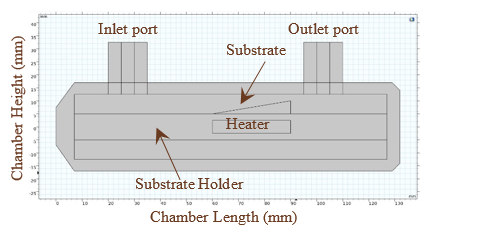Multiphysics modeling and optimisation of gas flow characteristics in a novel flow metric based gas sensing chamber with integrated heater

Keywords:
Gas sensing chamber, Boundary layer, flow in the chamber, Optimization, Gas Sensor, ModelingAbstract
Gas sensing is a very vital and commonly adapted process in various industries and service sectors. The gas sensing can be as mundane as exhaust gas from an automotive vehicle to as critical as a flammable, hazardous, or even toxic gas in environments where they find a considerable requirement, such as industries or in hospitals. It is crucial to detect the leakage of gases in these environments to maintain the operability of some systems or prevent catastrophic incidents in others. Various gas sensors have been developed to sense these gases present individually or as a mixture with other gases. The reliability of a gas sensor is highly dependent on the gas sensor calibrating or testing chamber. The credibility of the gas sensing chamber would dictate the gas sensors’ performance. A gas sensor needs to be observed or characterized for its characteristic such as sensitivity, selectivity, temperature-dependent response variation, sensing accuracy and precision, repeatability, response towards the exposed gas, response time, etc. These characteristics can be accurately studied only when the gas chamber’s behavioral characteristics are predetermined and well characterized. The paper intends to propose a flow metric-based gas sensing chamber against the conventional volumetric chamber and presents the gas flow nature in the chamber. The chamber is designed with a single inlet port and single exhaust vent or outlet port. The placement of the substrate holder with respect to the chamber dimensions, flow characteristics in the chamber has been optimized to provide a laminar flow over the substrate, resulting in higher sensing ability of the gas sensor. The paper also deals with the boundary layer suppression to provide maximal gas flow over the substrate, thereby enhancing the chance of sensing by the gas sensor. An integrated heater is also provided below the substrate holder, which is required since some gas sensors operate at high temperatures for optimal performance. Study on heat propagation from the heater onto the substrate holder is also involved. The flow characteristics of the entire chamber were analyzed, especially at the inlet port, over the substrate, and at the outlet port. The paper focuses on the complete modeling of the gas sensing chamber, fluid dynamic studies of the gas flow inside the chamber, optimal substrate placement, optimal angling of the substrate facing the gas flow, and the heat propagation from the heater onto the substrate holder.

